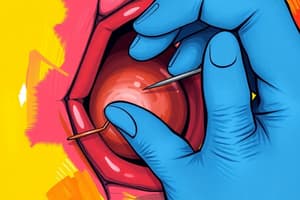Podcast
Questions and Answers
What is the PRIMARY purpose of performing a 'toilet' procedure on a wound?
What is the PRIMARY purpose of performing a 'toilet' procedure on a wound?
- To clean or wash the wound. (correct)
- To administer antibiotics directly to the wound site.
- To stimulate the production of collagen for faster healing.
- To close the wound edges using surgical staples.
A surgeon is closing a deep dermal laceration that requires significant tensile strength during the healing process. Which suture material would be MOST appropriate?
A surgeon is closing a deep dermal laceration that requires significant tensile strength during the healing process. Which suture material would be MOST appropriate?
- Nylon (correct)
- Vicryl
- Monocryl
- PDS
After a surgical procedure, a patient exhibits localized redness, swelling, and increased pain around the suture site. Which of the following complications is MOST likely occurring?
After a surgical procedure, a patient exhibits localized redness, swelling, and increased pain around the suture site. Which of the following complications is MOST likely occurring?
- Inflammation (correct)
- Bacterial Growth
- Bleeding
- Delayed Wound Healing
Which of the following is the MOST accurate description of performing a 'toilet and suture' procedure?
Which of the following is the MOST accurate description of performing a 'toilet and suture' procedure?
Why is the aseptic technique emphasized during a 'toilet and suture' procedure?
Why is the aseptic technique emphasized during a 'toilet and suture' procedure?
Flashcards
Toilet (Wound Care)
Toilet (Wound Care)
A procedure of cleaning or washing a wound to remove debris and prevent infection.
Suture
Suture
Stitches used to hold body tissues or wound edges together to facilitate healing.
Toilet and Suture
Toilet and Suture
Aseptic cleaning and stitching of wounds, minimizing the risk of infection.
Absorbable Sutures
Absorbable Sutures
Signup and view all the flashcards
Non-Absorbable Sutures
Non-Absorbable Sutures
Signup and view all the flashcards
Study Notes
Toilet and Suturing Basics
- Toilet is a wound cleaning or washing procedure.
- Suture refers to stitches applied to body tissues or wounds.
- Toilet and suture is a procedure where wounds are cleaned and stitched aseptically.
KKM Toilet and Suture Set
- The set includes various tools such as:
- Gauze
- Stainless steel containers
- Forceps
- Scissors
- Needle holders
Suture Classification: Absorbable
- Vicryl sutures are absorbable.
- Monocryl sutures are absorbable.
- PDS sutures are absorbable.
Suture Classification: Non-Absorbable
- Nylon sutures are non-absorbable.
- Polyester sutures are non-absorbable.
Suture Needle Parts
- The parts of a suture needle are the point, body and swaged end.
Suture Needle Size
- Suture needles come in different sizes, such as:
- Ferguson 1/2 circle 1842
- Ferguson 1 1/2 circle
Preparing and Assisting
- Key steps for preparation and assistance include:
- Verify the doctor's written prescription.
- Greet the patient, explain the procedure and its purpose.
- Assess the patient's level of pain.
- Assess the size and location of the wound.
- Wash hands.
- Prepare the trolley and equipment.
- Provide privacy.
- Position the patient comfortably.
- Place a protective sheet under the area to be stitched.
- Expose the wound area.
- Wear a mask and sterile gloves after washing hands.
Preparing to Stitch
- Essential steps in preparing to stitch involve: Prepare swabs for toileting. Choose an appropriate suture (type and size of needle). Thread the needle with suture material if using a traumatic type of suture. Hold the needle with the needle holder at the first 1/3 portion. Give local anesthesia if needed (or analgesics).
- Clean the wound with normal saline, adhering to aseptic principles.
Stitching Wound
- Ensure the correct method of suturing, including these steps:
- Begin with the edge of the wound further away.
- Start suturing from the center, using an adequate "bite" to bring the skin edges together.
- Hold the nearer edge of the wound with tooth dissecting forceps.
- Insert the needle into the skin and bring out in the middle of the wound.
- Pick the opposite edge of the wound.
- Insert the needle from under the skin outwards.
- Slowly pull the suture, leaving about 1 cm of suture.
- The material should remain at the skin surface opposite.
Tying and Reinforcing Knots
- Key steps in tying and reinforcing knots include:
- Make 2-3 forward turns of suture material around the needle holder.
- Grasp the 1 cm suture material opposite with the needle holder and pull through.
- Repeat 2-3 backward turns of suture material around the needle holder.
- Grasp the 1 cm part of the material opposite with the needle holder, and pull through again
- Reinforce with a minimum of 3 knots, alternating to prevent sutures breaking loose.
- Straighten the suture to allow for easier cutting.
- Cut the suture to approximately 0.5-1 cm.
- Be sure correct distance is maintained evenly between each suture
- Stitch wound until closed, ensuring adequate and equal tension to close approximation
- Clean wound with normal saline, and apply antiseptic spray if necessary and apply dressing
- Examine wound and ensure cleanliness is of a high standard.
Documentation and Patient Comfort
- Documentation of the procedure is essential.
- Create a reassuring atmosphere for the patient, for example:
- Offer comfort.
- Offer assistance.
- Gently pat the shoulder.
- Use reassuring words appropriate to the situation.
- Clean all equipment according to hospital guidelines.
Potential Complications
- Complications that may arise include:
- Bleeding
- Infection
- Bacterial growth
- Inflammation
- Delayed wound healing
Studying That Suits You
Use AI to generate personalized quizzes and flashcards to suit your learning preferences.




